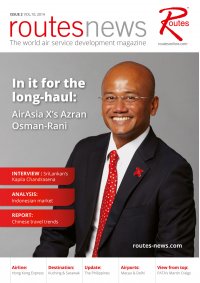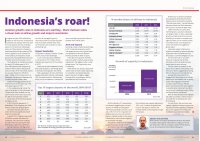AirAsia X is plotting its pan-Asian multi-base strategy, bolstered by a major aircraft order, chief executive officer, Azran Osman-Rani, explained to Lucy Siebert at our sister publication, Routes News.
In many ways, AirAsia X has put the long-haul low-cost debate to bed in Asia-Pacific. With a network of 17 destinations from Kuala Lumpur, the airline believes it has demonstrated the strength of the model in Asia-Pacific. AirAsia X listed on the Bursa Malays (formerly known as the Kuala Lumpur Stock Exchange) last year and is currently focused on beefing up its presence in key markets, including Korea, China and Australia. Its new sister Thai AirAsia X is also expected to get off the ground during 2014.
And it even has an eye on potentially resuming European operations in the future and has mentioned the possibility of one-stop services to North America in the long-term. But all its plans are based around establishing sustainable bases in its main markets.
Its CEO, Azran Osman-Rani, believes the initial public offering (IPO) really signalled to the rest of the industry that AirAsia X had well and truly arrived. “It is the first time a long-haul LCC has reached the stage of an IPO, which means the business model is not just about us saying it works, but investors have put their money behind it, that this is a viable business model, which is important psychologically,” he explains.
Going public also raised somewhere in the range of $230 million for the carrier, part of which has gone towards its US$6 billion aircraft order at list prices for 25 additional A330-300 aircraft, which, if all goes according to plan, could eventually allow the carrier to return to Europe with more efficient equipment.
AirAsia X’s first attempt to crack the European market resulted in it pulling flights to Paris and London in 2012, after operating to the European capitals for one and three years respectively. Now, it believes with new technology and more investment behind it, a second incursion could be on the cards later this decade.
AirAsia X currently operates 15 A330-300s on services from its Kuala Lumpur base to 17 destinations in Asia, Australia and Saudi Arabia. In addition to A330s, it also has 10 A350-XWB aircraft on order for future delivery. The order of 25 additional A330-300s, which includes extended range versions, means it could look at a return to Europe after 2016 – or could even consider a one-stop trans-Pacific service from Asia to North America.
Osman-Rani says he is excited about the opportunities the aircraft order presents. “That obviously makes the economics a lot more attractive. We are slated to take delivery of this variant in 2016, so it gives us the option to look at Europe as a possibility in that timeframe,” he says. “We are not going to commit now as it’s a few years away.”
For North America, Osman-Rani says the new A330-300s could allow AirAsia X to look at a one-stop trans-Pacific service via Japan, Taiwan or even the Philippines. “It [North America] still wouldn’t be accessible direct from KL, but for example if AirAsia Japan takes off again and it has a strong domestic network in Japan, that would give us the option to use that as a hub to go trans-Pacific,” he says.
While Osman-Rani is open-minded about the network possibilities for the future, he is adamant the long-haul airline will base its operations around its sister carrier AirAsia’s bases to ensure sufficient local and regional feed. “We are shadowing AirAsia as they set up hubs. Regions like Thailand, for example, are of immediate interest to us, because Thai AirAsia already has a very strong short-haul network there,” he says. “As AirAsia expands with a number of short-haul hubs, those become candidates for us to put long-haul planes in and set up our own hubs.”
His comments come after the airline axed Maldives from its network, citing “challenging business conditions” for the decision. The CEO cites the Philippines, India and Japan as potential future markets for expansion for AirAsia X but stresses that any incursions would depend on AirAsia’s scale and ability to provide feed to hubs in those countries.
Despite AirAsia India expecting to get off the ground this year, Osman-Rani says AirAsia X would take a cautious approach to that market. The airline previously served Mumbai and New Delhi before pulling out in 2012, and he says India remains a tough market for low-cost carriers due to its high airport and fuel costs and bureaucratic regulatory regime.
“It is a very large and complex market. It requires a lot of investment to build a brand, to build a distribution network, and we were simply sub-scale,” he says. “If AirAsia India were to invest there, lay the groundwork, set up distribution systems, build up the AirAsia brand to the point that it becomes a household brand name, then it paves the way for AirAsia X to ride on that. It is something we are looking at very keenly but we want to make sure AirAsia India leads it from the front.”
One market where AirAsia X appears to have found success beyond what it could first have imagined is Australia. It now flies to five Australian cities (Gold Coast, Sydney, Adelaide, Perth and Melbourne), making it the country’s fourth biggest international carrier. Not bad for a brand that only entered Australia in 2007 with its first ever long-haul flight to the tourism capital of the Gold Coast in Queensland.
Despite missing its target of serving five Australian cities within five years of operation – it got to Adelaide in its sixth year – the market has nonetheless proved to be a major success for AirAsia X. Osman-Rani attributes much of the airline’s success in Australia to its competitive airports and support from its tourism organisations. “It is certainly a market that has taken well to the low-cost carrier proposition; people feel comfortable buying online, airports are competitive, they understand that they need to structure pricing and services that suit a low-cost carrier,” he says.
Despite the success AirAsia X has found in Australia, Osman-Rani says the carrier won’t be making any sudden moves across the Tasman to New Zealand. It launched to Christchurch in April 2011, but pulled out in May 2012. While the CEO says he is “personally interested” in the market, he adds: “For 2014 we really need to focus on concentrating and building up a stronger position in our core markets.”
Thailand is one of those core markets and Thai AirAsia X is preparing to get off the ground soon. The carrier now has its Air Operators Certificate (AOC), and former music and entertainment executive, Nadda Buranasiri, has been appointed CEO. Osman-Rani says he is hopeful of a launch in the first quarter of 2014 and says the Thai subsidiary will focus on routes and destinations where the AirAsia brand is already known – likely to mean a network that includes Australia and China. So while the long-haul low-cost question is debated in conference rooms around the world, Osman-Rani believes AirAsia X will be leading from the front, with sustainable growth in its most important markets.
 |
DON'T MISS the latest issue of Routes News which is available at this year's Routes Asia and includes an EXCLUSIVE report on the Indonesian aviation industry. |  |





